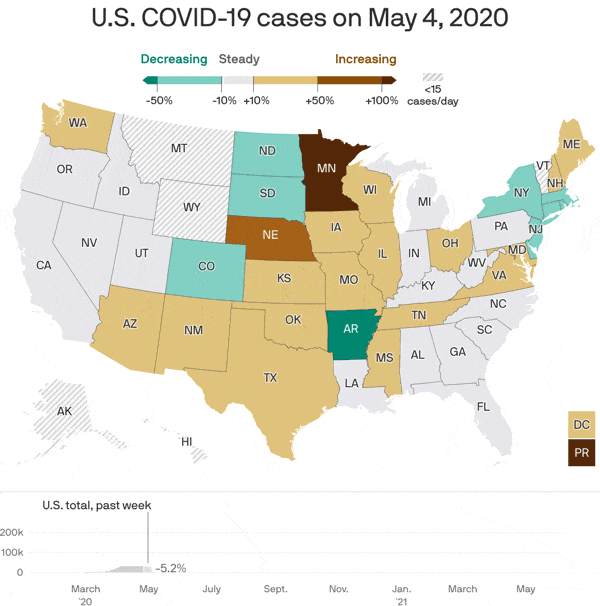[ad_1]
Data: The COVID Tracking Project, CSSE Johns Hopkins University, state health departments; Map: Andrew Witherspoon, Michelle McGhee/Axios
The U.S. has brought new coronavirus infections down to the lowest level since March 2020, when the pandemic began.
The big picture: Nearly every week for the past 56 weeks, Axios has tracked the change — more often than not, the increase — in new COVID-19 infections. Those case counts are now so low, the virus is so well contained, that this will be our final weekly map.
Get market news worthy of your time with Axios Markets. Subscribe for free.
By the numbers: The U.S. averaged roughly 16,500 new cases per day over the past week, a 30% improvement over the week before. New cases declined in 43 states and held steady in the other seven.
The official case counts haven’t been this low since Americans went into lockdown in March last year — when the pandemic was still new, no one knew how long this would go on, and inadequate testing meant that cases were undercounted.
Overall, roughly 33 million Americans — about 10% of the population — have tested positive for COVID-19.
About 595,000 people have died from the virus in the U.S., making it deadlier for Americans than the past 80 years of wars and other armed military conflicts combined, including World War II.
The U.S. largely failed to contain the virus until the vaccines arrived.
Cities and businesses began shutting down last March. From there, the virus rolled into a second wave last summer, when cases climbed to over 65,000 per day, on average, and hospitals in many parts of the country said they were overwhelmed.
That failure was then eclipsed in the winter, when hundreds of thousands of people per day were contracting the virus and deaths climbed over 3,000 per day for about a month.
But now, the virus really is under control, nationwide and in every state, thanks almost entirely to the vaccines. Just over half of American adults are now fully vaccinated, according to the CDC.
Story continues
What’s next: Cases and deaths are still soaring around the world, especially in the developing world, and the Biden administration is facing consistently mounting pressure to export more vaccines, now that the U.S. has contained the virus.
The U.S. was never able to control the virus without vaccines, and it still can’t. The risk is still about as high as it’s ever been for unvaccinated people, as the Washington Post recently reported. An average of about 500 Americans per day are still dying from COVID-19, almost all of them unvaccinated.
There will still be some localized outbreaks in the U.S., especially in areas where relatively few people are vaccinated. But they will likely be small, and vaccinated people will be protected.
Over time, the immunity from vaccines will likely wane, which, together with new variants of the virus, will likely require booster shots to stay ahead of another outbreak.
For now, though, the U.S. has finally gotten the virus down to a level that just about every expert agrees is safe. Fewer than 20,000 cases per day, spread across the U.S. population of 331.5 million people, is a relatively low number of cases, and that number continues to improve across the board.
New York, which bore the brunt of the virus’ arrival in the U.S., is now averaging about 800 new cases per day, in a state of some 20 million people.
Washington, D.C. has about 28 new cases per day.
Florida has more total cases per day — about 1,800, on average — than any other state. But again, that’s spread over a state with over 20 million people, and its numbers are improving just like the rest of the country’s. Florida’s daily case counts fell by 25% just this week.
The bottom line: The vaccines work. They’ve brought cases to their lowest point yet, and because that improvement is the result of vaccines, there’s no reason to believe the virus will start gaining significant ground again any time soon.
Cases in the U.S. are low, and they’re likely to stay low — which is why, after 56 weeks, this will be the end of our weekly map. Thank you for reading.
More from Axios: Sign up to get the latest market trends with Axios Markets. Subscribe for free
[ad_2]
Source link
